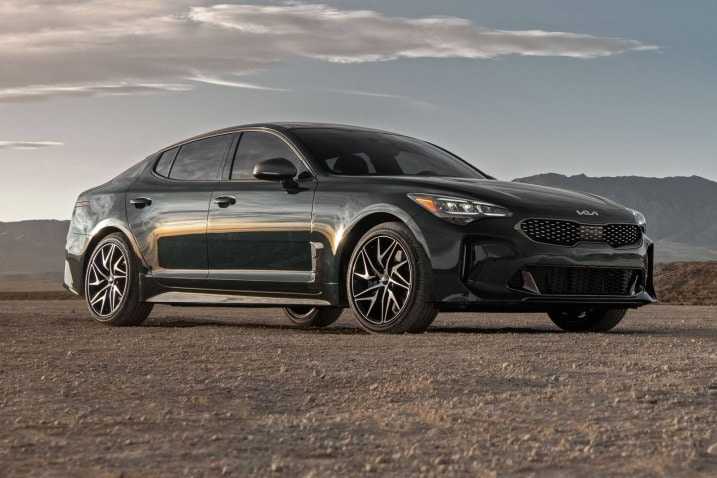Kia Stinger 2023 Introduction User Guide
The Kia Stinger 2023 is a sleek and powerful sports sedan that combines performance, style, and luxury. With its aggressive design, powerful engine options, refined interior, and advanced technology features, the Stinger offers an exhilarating driving experience. It features a choice between a 3.3-liter Twin-Turbo V6 engine and a 2.5-liter Turbocharged Inline-4 engine, both paired with an 8-speed automatic transmission. The Stinger 2023 boasts a comfortable and modern interior, equipped with a range of convenient and safety-enhancing technologies. With its blend of performance and sophistication, the Kia Stinger 2023 is a standout choice in the sports sedan segment.
Fuel requirements
For the optimal engine performance, we recommend you use unleaded gasoline which has an octane rating of RON (Research Octane Number) 95/AKI (Anti Knock Index) 91 or higher.
Using Unleaded gasoline with an octane rating lower than RON 95 could result in loss of engine power and increase in fuel consumption.
Your new vehicle is designed to obtain maximum performance with UNLEADED FUEL, as well as minimize exhaust emissions and spark plug fouling.
Never add any fuel system cleaning agents to the fuel tank other than what has been specified. (Consult an authorized Kia dealer for details.)
- Tighten the cap until it clicks one time, otherwise the Check Engine light will appear.

WARNING
Refueling
- Do not “top off” after the nozzle automatically shuts off. Attempts to force more fuel into the tank can cause fuel overflow onto you and the ground causing a risk of fire.
- Always check that the fuel cap is installed securely to prevent fuel spill-age, especially in the event of an accident.
Gasoline containing alcohol and methanol
Gasohol, a mixture of gasoline and ethanol (also known as grain alcohol), and gasoline or gasohol containing methanol (also known as wood alcohol) are being marketed along with or instead of leaded or unleaded gasoline.
Pursuant to EPA regulations, ethanol may be used in your vehicle.
Do not use gasohol containing more than 15% ethanol, and do not use gasoline or gasohol containing any methanol. Ethanol provides less energy than gasoline and it attracts water, and it is thus likely to reduce your fuel efficiency and could lower your MPG results.
Methanol may cause drivability problems and damage to the fuel system, engine control system and emission control system.
Discontinue using gasohol of any kind if drivability problems occur.
Vehicle damage or drivability problems may not be covered by the manufacturer’s warranty if they result from the use of:
- Gasoline or gasohol containing methanol.
- Leaded fuel or leaded gasohol.
- Gasohol containing more than 15%ethanol.
“E85” fuel is an alternative fuel comprised of 85 percent ethanol and 15 per-cent gasoline, and is manufactured exclusively for use in Flexible Fuel Vehicles. “E85” is not compatible with your vehicle. Use of “E85” may result in poor engine performance and damage to your vehicle’s engine and fuel system. Kia recommends that customers do not use fuel with an ethanol content exceeding 15%.
NOTICE
Your New Vehicle Limited Warranty does not cover damage to the fuel system or any performance problems caused by the use of “E85” fuel.
NOTICE
Never use any fuel containing methanol. Discontinue use of any methanol containing product which may inhibit proper drivability.
Other fuels
Using fuels that contain Silicone (Si), MMT (Manganese, Mn), Ferrocene (Fe), and Other metallic additives, may cause vehicle and engine damage or cause misfiring, poor acceleration, engine stall-ing, catalyst melting, clogging, abnormal corrosion, life cycle reduction, etc.
Also, the Malfunction Indicator Lamp (MIL) may appear.
NOTICE
Damage to the fuel system or performance problem caused by the use of these fuels may not be covered by your New Vehicle Limited Warranty.
Gasoline containing MMT
Some gasoline contains harmful manganese- based fuel additives Such as MMT (Methylcyclopentadienyl Manganese Tricarbonyl). Kia does not recommend the use of gasoline containing MMT. This type of fuel can reduce vehicle performance and affect your emission control system. The Malfunction Indicator Lamp on the cluster may come on.
Do not use methanol
Fuels containing methanol (wood alcohol) should not be used in your vehicle. This type of fuel can reduce vehicle performance and damage components of the fuel system, engine control system and emission control system.
Fuel Additives
Kia recommends that you use good quality gasolines treated with detergent additives such as TOP TIER Detergent Gasoline, which help prevent deposit formation in the engine. These gasolines will help the engine run cleaner and enhance performance of the Emission Control System. For more information on TOP TIER Detergent Gasoline, please go to the website (www.toptiergas.com)
For customers who do not use TOP TIER Detergent Gasoline regularly, and have problems starting or the engine does not run smoothly, additives that you can buy separately may be added to the gasoline.
If TOP TIER Detergent Gasoline is not available, one bottle of additive should be added to the fuel tank at every 8,000 miles (13,000 km) (for Smartstream G2.5 T-GDi), 6,000 miles (10,000 km) (for (Gasoline) 3.3 T-GDi) or every engine oil change is recommended. Additives are available from your authorized Kia dealer along with information on how to use them. Do not mix other additives.
Operation in foreign countries
If you are going to drive your vehicle in another country, be sure to:
- Observe all regulations regarding registration and insurance.
- Determine that acceptable fuel is available.
Vehicle modifications
This vehicle should not be modified. Modification of your vehicle could affect its performance, safety or durability and may even violate governmental safety and emissions regulations.
NOTICE
Damage or performance problems resulting from any modification may not be covered under warranty.
CAUTION
If you use unauthorized electronic devices, it may cause the vehicle to operate abnormally, wire damage, battery discharge and fire. For your safety, do not use unauthorized electronic devices.
Vehicle break-in process
By following a few simple precautions for the first 600 miles (1,000 km) you may add to the performance, economy and life of your vehicle.
- Do not race the engine.
- While driving, keep your engine speed (rpm, or revolutions per minute) between 2,000 rpm and 4,000 rpm.
- Do not maintain a single speed for long periods of time, either fast or slow. Varying engine speed is needed to properly break-in the engine.
- Avoid hard stops, except in emergencies, to allow the brakes to seat properly.
- Don’t tow a trailer during the first 1,200 miles (2,000 km) of operation.
- Fuel economy and engine performance may vary depending on vehicle break-in process and be stabilize after 4,000 miles (6,000 km). New engines may consume more oil during the vehicle break-in period.
Risk of burns when parking or stopping vehicle
WARNING
- Do not park or stop the vehicle near flammable items such as leaves, paper, oil, and tire. Such items placed near the exhaust system can become a fire hazard.
- When an engine idles at a high rpm with the rear side of the vehicle in close proximity of the wall, heat of the exhaust gas can cause discoloration or fire. Keep enough space between the rear part of the vehicle and the wall.
- Be sure not to touch the exhaust/catalytic systems while engine is running or right after the engine is turned off. There is a risk of burns since the systems are extremely hot.
Vehicle data collection and event data recorders
This vehicle is equipped with an Event Data Recorder (EDR). The main purpose of an EDR is to record, in certain crash or near crash-like situations, such as an air bag deployment or hitting a road obstacle, data that will assist in understanding how a vehicle’s systems performed. The EDR is designed to record data related to vehicle dynamics and safety systems for a short period of time, typically 30 seconds or less. The EDR in this vehicle is designed to record such data as:
- How various systems in your vehicle were operating;
- Whether or not the driver and passenger safety belts were buckled/fastened;
- How far (if at all) the driver was depressing the accelerator and/or brake pedal; and,
- How fast the vehicle was traveling.
These data can help provide a better understanding of the circumstances in which crashes and injuries occur.
NOTE: EDR data are recorded by your vehicle only if a non-trivial crash situation occurs; no data are recorded by the EDR under normal driving conditions and no personal data (e.g., name, gender, age, and crash location) are recorded. However, other parties, such as law enforcement, could combine the EDR data with the type of personally identifying data routinely acquired during a crash investigation.
To read data recorded by an EDR, special equipment is required, and access to the vehicle or the EDR is needed. In addition to the vehicle manufacturer, other parties, such as law enforcement, that have the special equipment, can read the information if they have access to the vehicle or the EDR.
Kia Stinger 2023 Your Vehicle at a Glance User Guide
Exterior overview
Front view
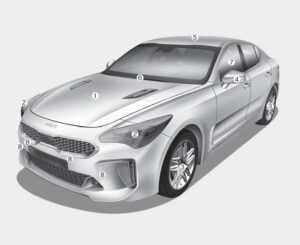
* The actual shape may differ from the illustration.
- Hood
- Head lamp (Features of your vehicle)
Head lamp (Maintenance) - Wheel and tire
- Outside rear view mirror
- Wide sunroof
- Front windshield wiper blades (Features of your vehicle) Front windshield wiper blades (Maintenance)
- Windows
- Front ultrasonic sensors
Rear view

* The actual shape may differ from the illustration.
- Door locks
- Fuel filler door
- Rear combination lamp (Maintenance)
- High mounted stop lamp (Maintenance)
- Liftgate
- Antenna
- Wide-rear view camera
- Rear ultrasonic sensors
Interior overview
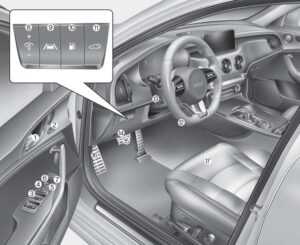
* The actual shape may differ from the illustration.
- Inside door handle
- Driver position memory button
- Power window switch
- Central door lock switch
- Power window lock button
- Outside rear view mirror control
- Outside rear view mirror folding
- Instrument panel illumination control
- Lane Safety button
- Fuel filler door open button
- Power liftgate open button
- Steering wheel
- Tilt and telescopic steering control
- Inner fuse panel
- Brake pedal
- Hood release lever
- Seat
Instrument panel overview

* The actual shape may differ from the illustration.
- Steering wheel audio control
Refer to “Car Infotainment System Quick Reference Guide” - Driver’s front air bag
- Horn
- Instrument cluster
- Wiper/washer
- ENGINE START/STOP button
- Driving Assist button
- Infotainment System
Refer to “Car Infotainment System Quick Reference Guide”. - Hazard warning flasher
- Automatic climate control system
- Shift lever A/T
Shift lever A/T (shift by wire) - Seat warmer
Air ventilation seat - Heated steering wheel button
- DRIVE MODE button
- Electronic parking brake (EPB) switch
- Auto Hold On/Off button
- Parking Safety button
- Parking/View button
- ISG OFF button
- Wireless smart phone charging system
- Center console storage box
- Power outlet
- Glove box
- Passenger’s front air bag
- USB charger
- Electronic stability control (ESC)
- USB port
- Light control
Engine compartment
Smartstream G2.5 FR T-GDi
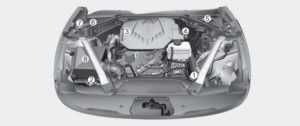
(Gasoline) 3.3 T-GDi
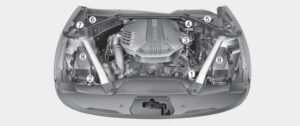
* The actual engine compartment in the vehicle may differ from the illustration.
* The battery is in the trunk.
- Engine coolant reservoir
- Radiator cap
- Engine oil filler cap
- Engine oil dipstick
- Brake fluid reservoir
- Fuse box
- Windshield washer fluid reservoir
- Air cleaner
Q &A
- What is the Kia Stinger 2023?
- The Kia Stinger 2023 is a midsize sports sedan produced by Kia Motors. It combines performance, style, and luxury features.
- What are the engine options available for the Kia Stinger 2023?
- The Kia Stinger 2023 is typically available with two engine options: a turbocharged 2.5-liter four-cylinder engine and a twin-turbocharged 3.3-liter V6 engine.
- What is the power output of the Kia Stinger 2023 engines?
- The turbocharged 2.5-liter four-cylinder engine produces around 300 horsepower, while the twin-turbocharged 3.3-liter V6 engine generates approximately 368 horsepower.
- Is the Kia Stinger 2023 available in all-wheel drive (AWD)?
- Yes, the Kia Stinger 2023 offers an available all-wheel drive system for enhanced traction and performance.
- What transmission options are available for the Kia Stinger 2023?
- The Kia Stinger 2023 typically comes with an eight-speed automatic transmission, providing smooth and responsive gear shifts.
- How many seats does the Kia Stinger 2023 have?
- The Kia Stinger 2023 is a five-seater sedan, offering comfortable seating for the driver and passengers.
- What are some key design features of the Kia Stinger 2023?
- The Kia Stinger 2023 features a sleek and sporty design, with aggressive styling cues, a low-slung stance, and aerodynamic lines.
- Does the Kia Stinger 2023 have advanced safety features?
- Yes, the Kia Stinger 2023 typically offers a range of advanced safety features, including lane-keeping assist, forward collision warning, blind-spot monitoring, and more.
- What technology and connectivity features are available in the Kia Stinger 2023?
- The Kia Stinger 2023 may include features such as an infotainment system with touchscreen display, smartphone integration (e.g., Apple CarPlay and Android Auto), Bluetooth connectivity, and a premium audio system.
- Does the Kia Stinger 2023 have a spacious trunk?
- Yes, the Kia Stinger 2023 provides a generously sized trunk, offering ample storage space for luggage and other items.
- What is the fuel efficiency of the Kia Stinger 2023?
- The fuel efficiency of the Kia Stinger 2023 can vary depending on the engine and driving conditions. Generally, it offers a balance of performance and efficiency for a sports sedan.
- Are there different trim levels available for the Kia Stinger 2023?
- Yes, the Kia Stinger 2023 typically offers multiple trim levels, each with its own set of features and options to suit different preferences and budgets.
- Does the Kia Stinger 2023 come with a warranty?
- Yes, Kia vehicles typically come with a comprehensive warranty package that covers various components of the vehicle for a certain period of time or mileage.
- Can I customize the Kia Stinger 2023 with additional features or options?
- Kia often provides various options and packages that allow buyers to customize their Stinger with additional features, such as upgraded audio systems, advanced safety packages, or performance enhancements.
- How does the Kia Stinger 2023 compare to other sports sedans in its class?
- The Kia Stinger 2023 offers competitive performance, stylish design, and a range of features at a relatively affordable

